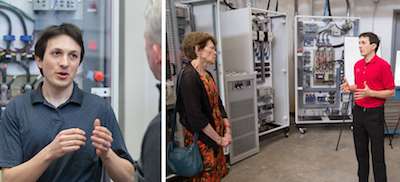Toward a more resilient and flexible power grid

"The biggest and most complex machine ever built by humankind." That is how University of Wisconsin–Madison doctoral student of electrical engineering Philip Hart describes the nation's power grid.
Hart and UW–Madison electrical and computer engineering professor Tom Jahns are part of a research team charged with the formidable task of transforming that big and complex machine from the inside out.
Hart says such a transformation will be necessary to allow for the seamless integration of renewable energy into the existing grid.
"Solar and wind technologies will be scaled up the most going forward," Hart says. "The main reason is economics, as the cost of solar photovoltaic (PV) rooftop panels has fallen precipitously during the past few years."
So why is it challenging to integrate many dispersed, or decentralized, small-scale power sources into the current grid? One reason is that solar PV generates a different type of electricity than traditional, utility-owned power plants whose generators connect to consumers by long transmission lines.
"This network of line-connected machines acts like a system of springs, masses, and dampers," Hart says. "When you disturb the springs, the masses will jump around, but usually reach their equilibrium again pretty quickly. Solar and energy storage technologies, however, are often interfaced by inverters that may react to disturbances in very different ways."
Inverters convert DC (direct current) electricity – the type generated by solar PV and batteries inside computers and cell phones – to AC (alternating current) electricity, the kind that forms the basis of today's power grid.
To integrate more inverter-based distributed generation into the grid, the researchers are developing a dynamic distribution system (DDS) that supplements centralized power plants, instead of replacing them.
A DDS consists of many functional clusters of energy-generating sources and energy-consuming loads. Each functional cluster has its own controller, and may even be able to function autonomously, but all clusters communicate with a higher-level controller via interconnected computers.
The DDS has several benefits: it is more resilient, with a smaller likelihood of system-wide blackouts, and better suited to providing combined heat and power, which boosts its efficiency. "It is much easier to make use of waste heat when the energy source is right next to your house, compared to a fossil fuel-powered plant at a distant site," Hart says.
Distributed generation and control is also better than the traditional grid at managing the intermittent nature of renewable energy. When the sun stops shining or the wind stops blowing, a small generator or energy storage source can ramp up electricity production much faster than a large power plant, and ramp down again when renewable sources return.
"The great thing about the DDS is that it can be implemented incrementally," Hart says. "That minimizes required infrastructure changes and will help keep electricity affordable. Our long-term goal is for the DDS to be a more resilient system than the current grid that deliver benefits to both utilities and customers."
Provided by University of Wisconsin-Madison


















